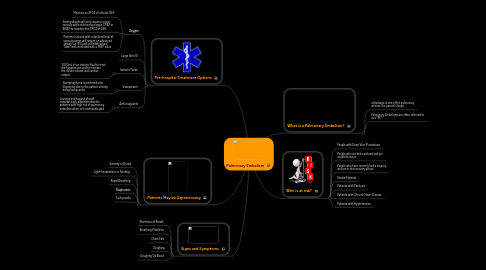Pulmonary Embolism
da James Via


1. Pre-hospital Treatment Options
1.1. Oxygen
1.1.1. Maintain an SPO2 of at least 94%
1.1.2. Some patients will only require a nasal cannula while others may requie CPAP or BiPAP to maintain the SPO2 of 94%
1.1.3. Patients in shock with a declined level of consciousness will require an advanced airway (i.e. RSI and an Endotracheal Tube) and ventilated with a PEEP valve
1.2. Large Bore IV
1.3. Isotonic Fluids
1.3.1. 1,000mL of an isotonic fluid to treat the hypotension and to increase the stroke volume and cardiac output
1.4. Vasopressor
1.4.1. Norepinephrine is preferred over Dopamine due to the patient already being tachycardic
1.5. Anticoagulants
1.5.1. Lovenox and heparin should consider early administration for patients with high risk of pulmonary embolism when not contraindicated

